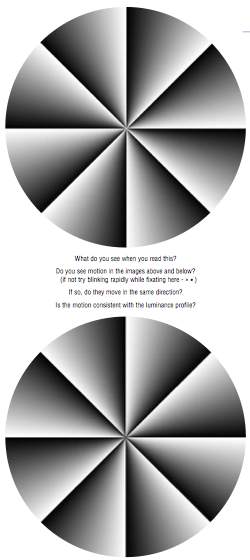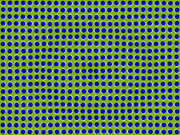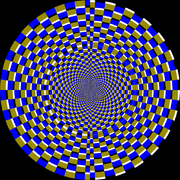
Peripheral drift illusion
Encyclopedia

The peripheral drift illusion (PDI) refers to a motion illusion
Optical illusion
An optical illusion is characterized by visually perceived images that differ from objective reality. The information gathered by the eye is processed in the brain to give a perception that does not tally with a physical measurement of the stimulus source...
generated by the presentation of a sawtooth luminance grating in the visual periphery. This illusion was first described by Faubert
Jocelyn Faubert
Prof. Jocelyn Faubert is a psychophysicist best known for his work in the fields of visual perception, vision of the elderly, and neuropsychology. Professor Faubert holds the NSERC-Essilor Industrial Research Chair in Visual Perception and Presbyopia. He is the director of the Laboratory of...
and Herbert (1999), although a similar effect called the "escalator illusion" was reported by Fraser and Wilcox (1979). A variant of the PDI was created by Kitaoka and Ashida (2003) who took the continuous sawtooth luminance change, and reversed the intermediate greys. Kitaoka has created numerous variants of the PDI, and one called "rotating snakes" has become very popular. The latter demonstration has kindled great interest in the PDI.
The illusion
Illusion
An illusion is a distortion of the senses, revealing how the brain normally organizes and interprets sensory stimulation. While illusions distort reality, they are generally shared by most people....
is easily seen when fixating off to the side, and then blinking as fast as possible. Most observers see the illusion easily when reading text (such as this article) with the illusion figure in the periphery. Motion is consistently perceived in a dark-to-light direction, so the two circles to the right should spin in opposite directions.
Two recent papers have been published examining the neural mechanisms involved in seeing the PDI (Backus & Oruç, 2005; Conway et al., 2005). Faubert and Herbert (1999) suggested the illusion was based on temporal differences in luminance
Luminance
Luminance is a photometric measure of the luminous intensity per unit area of light travelling in a given direction. It describes the amount of light that passes through or is emitted from a particular area, and falls within a given solid angle. The SI unit for luminance is candela per square...
processing producing a signal that tricks the motion system. Both of the recent articles are broadly consistent with those ideas, although contrast
Contrast (vision)
Contrast is the difference in visual properties that makes an object distinguishable from other objects and the background. In visual perception of the real world, contrast is determined by the difference in the color and brightness of the object and other objects within the same field of view...
appears to be an important factor (Backus & Oruç, 2005).


External links
- Rotating snakes at Akiyoshi's illusion pages
- Rotating rings at Sarcone's optical illusion pattern page

